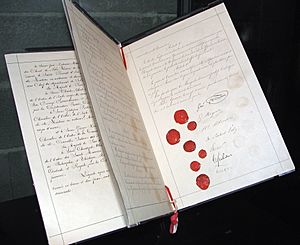Laws of war facts for kids
The Laws of war are like a set of rules that countries agree to follow during a conflict. Even though war is about fighting, these rules exist to make sure things don't get worse than they need to be. They aim to protect people who are not fighting, like civilians, and to limit the harm caused by battles. These rules are also known as International humanitarian law.

The First Geneva Convention governing the sick and wounded members of armed forces was signed in 1864.
Contents
Protecting People and Places in War
Here are some of the main rules that countries try to follow during a war:
- Helping the Injured: Places like hospitals, ambulances, and people like doctors or first aid workers should never be attacked. These places and people are meant to help those who are hurt, and they should not carry weapons.
- Neutral People: If someone belongs to a country that is not involved in the war (a "neutral power"), they should not be attacked. This is unless they are actively taking part in the fighting.
- Identifying Fighters: Anyone fighting in a war must wear a uniform that clearly shows which side they are on. They also need to carry their weapons where everyone can see them. This helps tell fighters apart from civilians.
- White Flag: If someone is carrying or waving a plain white flag or a piece of white cloth, they must not be attacked. This person should also not attack anyone else. A white flag usually means they want to surrender, or they want to talk about finding a peaceful solution.
- Prisoners of War: Any enemy soldier who is captured must be treated fairly. They are called a prisoner of war and have certain rights.
- Protecting Important Buildings: Religious buildings like churches, mosques, and temples are very important to people and should be protected at all times.
- Governing Occupied Areas: If one army takes control of another country's land (called an occupied territory), they must govern it fairly. They are not allowed to steal things or destroy the area.
Where Do These Rules Come From?

The signing of the First Geneva Convention by some of the major European powers in 1864.
These rules come from different international agreements called treaties. Countries sign these treaties to agree on how wars should be fought. Some of the most important treaties include:
- The Paris Declaration of 1856: This agreement stopped "privateering," which was when private ships were allowed to attack enemy ships during wartime.
- The First Geneva Convention of 1864: This was a very important step. It created rules to protect wounded and sick soldiers on the battlefield. It was the first of many Geneva Conventions.
- The St. Petersburg Declaration of 1868: This treaty banned certain types of dangerous ammunition. For example, it made it illegal to use small bullets that explode or break apart easily. However, larger weapons like artillery could still use such ammunition.
- The Hague Conventions of 1898 and 1907: These were a series of meetings that created more rules about how wars should be fought, including rules about how to treat prisoners and what kinds of weapons are allowed.
- Other Geneva Conventions: Over the years, more Geneva Conventions were created. They added rules to protect civilians, prisoners of war, and people at sea during conflicts.
- The United Nations Charter: The United Nations was formed after World War II to promote peace. Its charter includes rules about when countries can use force.
- The Convention on Certain Conventional Weapons: This modern treaty bans or restricts the use of specific weapons that cause too much harm or hit people randomly. This includes some types of landmines, weapons that spread fragments, incendiary devices (weapons that cause fires), and blinding laser weapons.
Images for kids
See also
 In Spanish: Leyes de la guerra para niños
In Spanish: Leyes de la guerra para niños

All content from Kiddle encyclopedia articles (including the article images and facts) can be freely used under Attribution-ShareAlike license, unless stated otherwise. Cite this article:
Laws of war Facts for Kids. Kiddle Encyclopedia.

